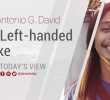I pushed for Leo Deriada’s proclamation as National Artist for Literature here last week. But he is far from the only qualified writer for the honor.
Being named National Artist involves a complicated series of nominations, endorsements and deliberations before the President proclaims a choice, with key controversial factors as diverse as language medium, politics, and poetics influencing the many stages of the process. A lifetime of experience, a body of influential works, and lasting contribution to national identity are prerequisites, but the National Artist is also usually the writer whose work and image as a man or woman of letters fits into the times and the literary climate. As such, a writer will also only have a chance if there is a considerably concerted effort to push for him or her to be proclaimed a National Artist.
That being said, several writers’ names are being circulated around the literary circles as likely contenders. I list those I’ve heard here, the writers who are being pushed by a significant body of other writers to be given the honor. But make no promises that one of these contenders will indeed be proclaimed, or that the list is exhaustive.
These are the writers among whom the next National Artist for Literature might be named.
Leonicio Deriada. I’ve already written about my manok here. The Old Man of Davao Fiction and Father of Western Visayan Literature is being actively pushed by the writers in Iloilo, Antique, and Aklan (he is currently based in Iloilo, where he is an emeritus professor in UP Visayas Miag-ao). He has already been nominated by several writers groups in Mindanao. But most tellingly has the endorsement of two of the four living National Artists for Literature. Of all the contenders he has the most national clamor – clearly I am campaigning here.
Gemino Abad. The name being circulated as the Manila establishment’s bet is the stalwart Jimmy Abad. This writer’s family is from Cebu (his father Antonio was the last great Spanish novelist in the country), but he has lived much of his life in Manila and writes mostly in English. Abad is associated with UP Dilliman, where he is Emeritus University Professor (the most senior rank of professor in the university). Sir Jim is a living legend – he is most known for his influential anthologies, and for his idea of Filipino writing in English as ‘writing from English,’ the Filipino owning this colonial language by using it in spite of its foreignness to articulate the native identity.
Merlie Alunan. Rivaling Leoncio in pan-regionalism, Merlie Alunan is also a prolific writer who writes in many languages. While she mostly writes in English, she’s had a book in Cebuano out (and has translated to English from Cebuano), but is being pushed by the group of writers in Eastern Visayas, where she has been influential in the revival of Waray Literature. Like the two above she has links to UP, being professor in UP Visayas Tacloban. I remember the poet Larry Ypil saying how Alunan has chronicled for the country its collective grief: her body of poetry stands out for its treatment of tragedies, from the storms that frequently hit Samar, to the horrors of war. Her most popular work is the much-anthologized poem “Bringing the Dolls.” Alunan is also one of the most poignant and most insightful voices into the identity and condition of the Filipina.
Resil Mojares. One of the grand senyors of Cebu (where the writers are pushing for him), Resil Mojares is as intellectual as you get (even more than Jimmy Abad, and that’s saying a lot). He started out as a literary writer, but is now a historian, critic, biographer, and linguist. Mojares is influential in starting the academic study of Cebuano, having founded the Cebuano Studies Center of the University of San Carlos. He is also a noted biographer of historical personalities, ranging from national figures like the prime minister Pedro Paterno and religious revolutionary Isabelo delos Reyes, to local figures in Cebu like the Aboitiz family and the novelist-senator Vicente Sotto. When he was asked to formally introduce Mojares as a keynote speaker during a literary conference, Deriada began humourously: “If you are a self-respecting academic, you do not need an introduction to Resil Mojares. But to the heathens among you, I will read his short bio.”
Again, this list is by no means exhaustive. There are many other very qualified writers who are not on this list, and may well be nominated and named National Artist instead.
But I name these contenders here because the process of choosing a National Artist is a great opportunity for us to get to know our brilliant but little-known writers. Whether or not they are declared, these names are worth knowing. So when you find their names in your nearest bookstore, pick them up and start reading our country’s great body of literature! (davaotoday.com)
Karlo Antonio G. David is a writer based in Davao. His interests include the Mindanao settler identity, the hybridization of the Filipino languages (with specific focus on Davao Filipino), and the development of local historiography and introspection, particularly of his hometowns of Kidapawan and Davao. His one-act play, Killing the Issue, won the second prize in the 2014 Palanca Awards.
Gemino Abad, Leonicio Deriada., Merlie Alunan, Resil Mojares






